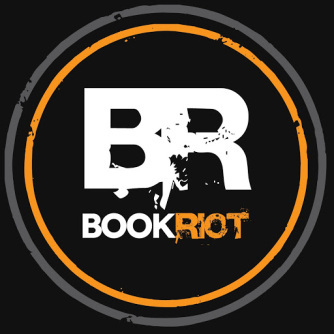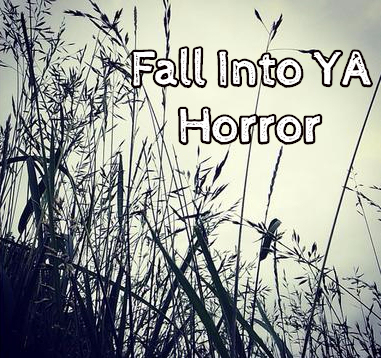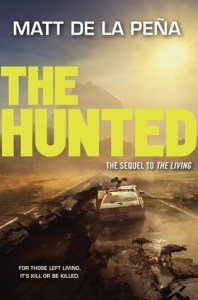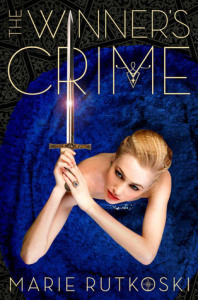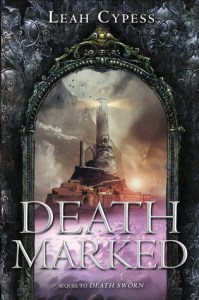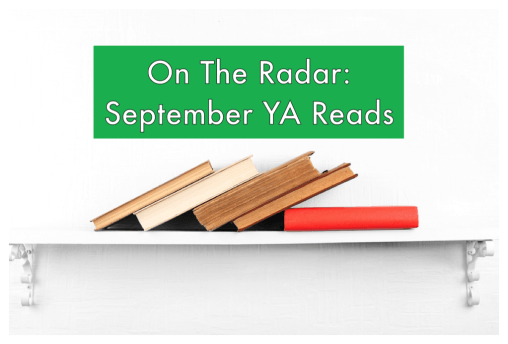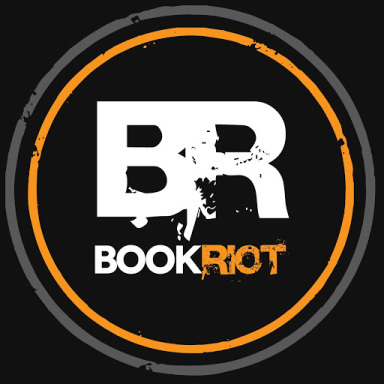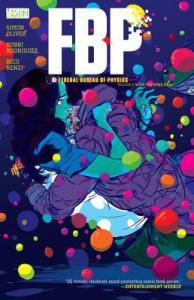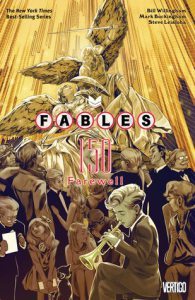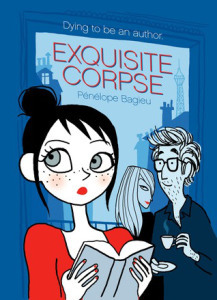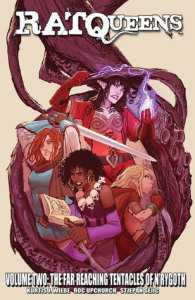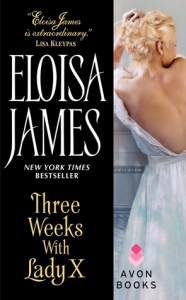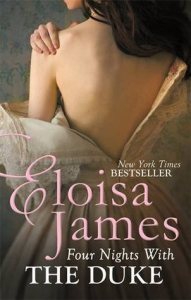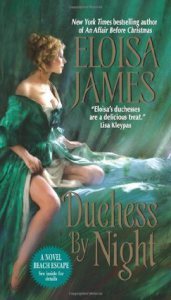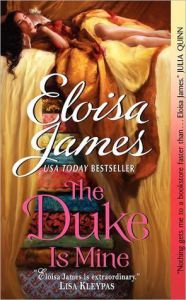Kelly Jensen's Blog, page 79
September 7, 2015
Long weekend reading part 1: Lumberjanes
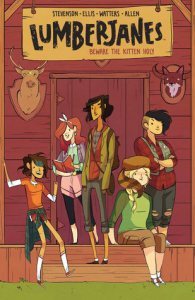 Long weekends are for reading comics about girls who go on adventures. Or at least, that’s how my Labor Day weekend shaped up. First up was Lumberjanes, which I’d actually tried to purchase from two different comic book stores on two separate occasions and failed both times, as they had run out. Luckily, my library has all of the digital singles.
Long weekends are for reading comics about girls who go on adventures. Or at least, that’s how my Labor Day weekend shaped up. First up was Lumberjanes, which I’d actually tried to purchase from two different comic book stores on two separate occasions and failed both times, as they had run out. Luckily, my library has all of the digital singles.
I’m a little late to the party on the Lumberjanes love, but if you’re like me and haven’t read it yet, here’s the gist: a group of five girls (they all seem to be around 12) are rooming in the same cabin at a camp similar to a Girl Scout camp. It’s a camp for “hard-core lady-types,” aka the Lumberjanes. They get caught up in a series of adventures involving a woman who turns into a bear, foxes who disappear, a secret underground cave, and lots of other fun magic. They also do the normal camp stuff like play capture the flag and make friendship bracelets.
The premise on its own sounds fun (and it is), but what makes this comic special is the humor, most of which is derived from the really great friendships between the girls. This is the first comic I’ve read where it feels like making the reader laugh is one of the main goals, not just a secondary one. And it succeeds really well – I was chuckling aloud to myself the entire time. This is actually a swear-free comic, so the girls say things like “What the junk!” and “What the Phillis Wheatley were you thinking?” instead. They earn badges like “naval gauging” and “everything under the sum” (a math-related badge). And the girls are awesome friends. One of their catchphrases is “Friendship to the max!” which serves as a sort of battle cry as they head into their next adventure. Their friendship is important to each other and it’s clear they care deeply for each other. I feel like they could be the pre-teen versions of the Rat Queens in some ways. And each girl is distinct in personality as well as look (including skin tone).
As a girl who went to Girl Scout summer camp a few times growing up, I appreciate the clever ways Noelle Stevenson, Grace Ellis, and Brooke Allen work with the tropes of such a camp. I can say that I probably would have had a much better time if we fought raptors and solved anagrams in underground caves guarded by animated statues, but then it probably also would have been shut down pretty quickly. (One of the main points of humor in the story is the girls’ hapless counselor who can’t keep her wayward campers from getting into scrapes or make the boss lady understand there are really weird things going on). There’s an overarching storyline – what exactly is going on at the camp? – which provides the impetus to keep reading, but really, I’d read it even if each issue were a totally different story. This is definitely a winner (literally, too, since it’s won two Eisners). One of those Eisners was for best publication for teens, but I’d say this is totally appropriate for and appealing to middle grade readers as well. Highly recommended.







 Related StoriesPrison Island by Colleen FrakesGraphic Novel RoundupThe Warrior, the Lover, and the Cultist: Three Brief Reviews
Related StoriesPrison Island by Colleen FrakesGraphic Novel RoundupThe Warrior, the Lover, and the Cultist: Three Brief Reviews
September 3, 2015
This Week at Book Riot
Here’s a round-up of my (very busy) week over at Book Riot:
I fell down a rabbit hole looking at sand sculptures last week and decided to do a big round-up of bookish sand sculptures. And they are nothing short of amazing.
I followed that up with a round-up of some awesome book shelves for you real or imaginary home.
In this week’s “3 on a YA Theme,” I highlighted a handful of witch and witchcraft in YA books.
I’m starting a new monthly feature about the month in YA news, highlighting some of the biggest stories, discussions, and deals in the world of YA. Here’s the first edition.







 Related StoriesThis Week at Book Riot
Related StoriesThis Week at Book Riot
September 2, 2015
Fall into YA Horror
It’s getting closer and closer to one of the best times of year: fall. Technically, fall doesn’t kick off until September 23, but at least here in Wisconsin, the weather is already starting to make a little bit of a turn. Don’t get me wrong, I love summer fiercely. But there’s something about fall that really sits well with me, and I love how I feel like I’m allowed to stay in and ready scary books just because it’s the “right time” to do that.
I’ve written extensively about YA horror before, here and at School Library Journal, but I haven’t talked about what’s been hitting shelves in horror lately. It’s a big season of solid horror reads, too — I’ve been tearing through them and think that even though horror is and always has been a staple of YA, it’s getting a little more of the spotlight now. This isn’t a bad thing.
Here’s a big round-up of recent and upcoming YA horror novels. All descriptions come from WorldCat, and for the books I’ve read, I’ve added a bit of my thoughts about the title. Consider this your fall reading list.
The Accident Season by Moira Fowley-Doyle: Every October Cara and her family become mysteriously and dangerously accident-prone, but this year, the year Cara, her ex-stepbrother, and her best friend are 17, is when Cara will begin to unravel the accident season’s dark origins.
The Bargaining by Carly Anne West: Grieving and guilty over a friend’s death, Penny is not surprised when her mother sends her to live with her father and stepmother, April, but when April takes her to help restore an old house in a dense forest, weird occurences connected to missing children threaten Penny’s safety and fragile mental health.
Bits & Pieces by Jonathan Maberry: Twenty-two short stories, eleven of which were previously published, based on the Rot & Ruin series in which fifteen-year-old Benny Imura and his friends fight a zombie plague in a post-apocalyptic America. Includes a related comic book script.
Blood and Salt by Kim Liggett: Seventeen-year-old Ash Larkin finds out her family is involved in a centuries-old saga of love and murder, alchemy and immortality when she follows her mother to an isolated settlement in the cornfields of Kansas.
The Creeping by Alexandra Sirowy: Seventeen-year-old Stella has no recollection of the day her best friend disappeared while the two, then six, were picking strawberries, until the corpse of a similar girl turns up and Stella not only begins to remember, she learns that something dark has been at work in their little town for generations.
The Crimson Gate by Whitney A. Miller: Harlow Wintergreen, now the new Matriarch of VisionCrest, the powerful religious organization previously led by her father, is trapped inside a Cambodian temple, but she must escape and thwart her double, the evil Isiris, who is masquerading as Harlow in order to bring disease and destruction to the world.
The Dead Girls of Hysteria Hall by Kate Alender: Sixteen-year-old Cordelia and her family move into the house they just inherited in Pennsylvania, a former insane asylum the locals call Hysteria Hall–unfortunately the house does not want defiant girls like Delia, so it kills her, and as she wanders the house, meeting the other ghosts and learning the dark secrets of the Hall, she realizes that she has to find a way to save her sister, parents, and perhaps herself.
Verdict: I loved this, and it’s hands-down one of the best books I read this year. It’s a fast-paced, extremely intelligent, and feminist horror story with a lead character who is smart. I find myself getting frustrated with leads in horror frequently, but Delia doesn’t disappoint. Alender writes suspense so well — this was my first book by her and it won’t be my last. I’m eager to dive into her backlist. This one is more gothic than gore.
The Dead House by Dawn Kurtagich: Told through journal entries, a psychotherapist’s notes, court records, and more, relates the tale of Carly, a teen who was institutionalized after her parents’ death but released to Elmbrige High School, where she is believed to have a second personality or soul named Kaitlyn, and/or be possessed by a demon.
Dead Investigation by Charlie Price: Since the affair of the murdered cheerleader, seventeen-year-old Murray has moved into the lawnmower shed at the town cemetery, where he is close to the dead that he talks to and considers friends–but the caretaker’s daughter, Pearl, wants him to use his gift to find a homeless man who seems to have disappeared, and may have been murdered by someone who is hunting the homeless.
Daughters Unto Devils by Amy Lukavics: When sixteen-year-old Amanda Verner’s family decides to move from their small mountain cabin to the vast prairie, she hopes it is her chance for a fresh start. She can leave behind the memory of the past winter; of her sickly Ma giving birth to a baby sister who cries endlessly; of the terrifying visions she saw as her sanity began to slip, the victim of cabin fever; and most of all, the memories of the boy she has been secretly meeting with as a distraction from her pain. The boy whose baby she now carries.
When the Verners arrive at their new home, a large cabin abandoned by its previous owners, they discover the inside covered in blood. And as the days pass, it is obvious to Amanda that something isn’t right on the prairie. She’s heard stories of lands being tainted by evil, of men losing their minds and killing their families, and there is something strange about the doctor and his son who live in the woods on the edge of the prairie. But with the guilt and shame of her sins weighing on her, Amanda can’t be sure if the true evil lies in the land, or deep within her soul.
Verdict: I read a review calling this “Children of the Corn” meets “Little House on the Prairie” and that’s perfect. This is classic horror set in the 1800s — but that’s not actually stated in text. It’s inferred by the way the story is written, which is old time-y. But readers who see this as current times could be believed too, as Lukavics builds a story that isn’t about setting but about voice, about tension, and about delivering real deal chills. Horror fans who are genre fiends will dig this, and it could be a solid introduction to those who want to be horror readers and are ready for an all-out horror fest. More gore than gothic. Remember, it’s the prairie.
The Devil and Winnie Flynn by Micol Ostow and David Ostow: While working as a production assistant on her aunt’s television show about the paranormal, a seventeen-year-old girl discovers a psychic ability of her own, which may provide clues to her mother’s death.
Verdict: I called this my favorite book of June for a reason. This is a fun read that plays on tropes through the lens of reality television. It toys with so many of the things I love — format is unique, it explores the “other side” of “reality” TV, and it digs into the urban legend of the Jersey Devil. This one is light on scares and more about exploring the backside of horror, so it’s one you could hand to your more easily scared readers. Diehard genre fans, though, will find a lot to enjoy here BECAUSE they’ll pick up on the tropes. It’s smart.
The Dogs by Alan Stratton: Set in a remote part of the Canadian countryside, THE DOGS is a first person narration by 15 year old Cameron. He and his mother have just moved yet again to keep out of the way of Cameron’s violent father. This time their new ‘home’ is a deserted old farmhouse with a disturbing history.
The Diary of a Haunting by M. Verano: After her parents’ high-profile divorce, sixteen-year-old Paige is forced to leave Los Angeles for a rambling Victorian mansion in small-town Idaho where she soon notices strange occurrences that seem to be building toward some unspeakable horror.
Nightfall by Jake Halpern and Peter Kujawinsa: On a distant island where day and night exist on fourteen-year cycles, and the islanders migrate south each sunset, three children get left behind and must find a way off the island before the Night finds them.
Return to the Dark House by Laurie Faria Stolarz: Ivy Jensen escaped the Dark House–but the haunting memories of the friends she left behind remain. As the trail for the killer grows cold, it’s up to Ivy to end the nightmare. Forever.
Sanctuary by Jennifer McKissack: After the sudden death of her aunt, Cecilia Cross is forced to return to the old mansion on a remote island off the coast of Maine, ironically named Sanctuary, the place where her father and sister died, and from which her mother was committed to an insane asylum soon after–and it is also a place of dark secrets, haunted by the ghosts of its original owners, and inhabited by her vicious uncle.
Slasher Girls & Monster Boys edited by April Genevieve Tucholke: Inspired by classic tales and films, a collection of fourteen short stories ranging from bloody horror, to psychological thrillers, to supernatural creatures, to unsettling, all-too-possible realism, by acclaimed YA authors of every genre.
Verdict: I’m about half-way through this collection as I write this, and I’ve been really impressed with the stories so far. There is something for every kind of horror fan and it’s a good anthology of stories, as they all feel different and lend themselves to reading in one big gulp or in small spurts (like I prefer).
The Suffering by Rin Chupeco: When an old friend disappears in Aokigahara, Japan’s infamous ‘suicide forest,’ Tark and the ghostly Okiku must resolve their differences and return to find her. In a strange village inside Aokigahara, old ghosts and an ancient evil lie waiting.
Thirteen Chairs by David Shelton: When Jack enters the deserted house in his neighborhood, he finds a group of people who invite him to take the thirteenth chair in the room and share a story–in the house where the ghosts meet.
Took by Mary Downing Hahn: A witch called Old Auntie is lurking near Dan’s family’s new home. He doesn’t believe in her at first, but is forced to accept that she is real and take action when his little sister, Erica, is ‘took’ to become Auntie’s slave for the next fifty years.
The Unquiet Past by Kelley Armstrong: Tess has always been tormented by waking visions that make her question her sanity. When the orphanage she lives in burns down, she decides to face her fears and find out once and for all what is wrong with her. She believes the truth must lie with her parents, and so, armed with only an address and phone number, Tess travels to a crumbling mansion in rural Quebec, where she discovers evidence of mistreatment of mental patients. She also makes an unlikely ally and gradually unearths her family’s sad history—and finally accepts the truth about her paranormal powers.
What We Knew by Barbara Stewart: When Tracy and her best friend, Lisa, were kids, stories about a man — a creep who exposes himself to little girls — kept them out of the woods and in their own backyards. But Tracy and Lisa aren’t so little anymore, and the man in the woods is nothing but a stupid legend. Right? But someone is in the woods. Someone is watching. And he knows all their secrets, secrets they can’t tell anyone — not even each other. Lisa’s just being paranoid. At least that’s what Tracy thinks. But when a disturbing “gift” confirms her worst fears, it sets the girls on a dangerous journey that takes them beyond the edge of the woods. But reality is more terrifying than the most chilling myth, and what they find will test the bonds of friendship, loyalty, and love. Tracy and Lisa can’t destroy the evil they’ll face, but can they stop it from destroying each other?
We’ll Never Be Apart by Emiko Jane: Haunted by memories of the fire that killed her boyfriend, seventeen-year-old Alice Monroe is in a mental ward when, with support from fellow patient Chase, she begins to confront hidden truths in a journal, including that the only person she trusts may be telling her only half of the story.
Verdict: Well, I’ll be honest — I guessed this one from about page 5. I could have figured it out by the description alone what was going to happen. But I’m also fairly comfortable with horror tropes, and this didn’t stray from a familiar one. That’s not a bad thing for those who aren’t so well versed, but the downfall is that with horror, as opposed to some other genres, I find reading the story becomes less about enjoying the story as it’s written and more about guessing whether or not my hunch is correct. This isn’t a bad book, and it’s certainly worth reading. It’s much more on the psychological side of horror than on the gore or gothic side. I believe, but am not 100% certain, that the author may be a woman of color, which is absolutely worth noting because diversity in horror (in YA and in adult) is sorely lacking. I sound wishy-washy on this title because I can’t fairly evaluate the horror element of it, but I can say the writing was solid and I would absolutely pick up another book by Jean.







 Related StoriesGuess The YA Book By Its Subject HeadingsExperimental Hybrid NovelsOn The Radar: 14 September YA Reads
Related StoriesGuess The YA Book By Its Subject HeadingsExperimental Hybrid NovelsOn The Radar: 14 September YA Reads
September 1, 2015
What I’m Reading Now
Cybils season is starting up, which means the books I helped pick for the shortlist last year have been on my mind the past couple of weeks. So naturally, I’ve been working my way through the sequels of some of the finalists.
The Hunted by Matt de la Pena
Like its predecessor The Living, The Hunted so far is fast-paced and doesn’t shy away from life-threatening situations. Shy makes it back to the California coast, and it’s completely devastated. He has to survive in the changed landscape as well as avoid the people hunting him thanks to what he discovered at the end of the previous book. Shy’s voice is strong and I expect (hope) I’ll like this one as much as I did the first.
The Winner’s Crime by Marie Rutkoski
I started this one a long time ago and I still haven’t finished it. It’s not because it’s bad; exactly the opposite. It’s so good that it hurts to read it. I haven’t been in the mood for books that give me a lot of feelings, and this series is full of feelings – war, thwarted love, betrayal, and no good choices for anyone. It’s the second book in a trilogy, which means it’s practically guaranteed to end unhappily. I’ve been sticking to a lot of happily-ever-afters in my reading choices lately. Still, I think this long weekend is the time to finish it up. And then sob.
Death Marked by Leah Cypess
This is a duology, not a trilogy, meaning this volume should provide a conclusion to Ileni’s story and hopefully avoid the second-book heartache that often occurs in middle installments. At the beginning of this sequel, Ileni is a captive of the Empire, forced to learn fighting magic with the assistance of lodestones. Of course, she hates it, and she also has to contend with some dangerous fellow students with their own agendas. I’m not far enough into the book to determine if I’ll like it as much as the first, but I’m hoping it will impress me just as much with its clever, intelligent plotting.
Sound by Alexandra Duncan
I only wish I were reading this one. It publishes September 22 and I will be first in line to get it (metaphorically speaking).








August 31, 2015
Prison Island by Colleen Frakes
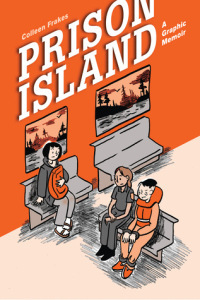 One of my favorite kinds of nonfiction is the graphic memoir. Absorbing the author’s art alongside the text gives me insight into the author’s experiences that I wouldn’t have gotten otherwise. I get to see how they picture themselves and the world around them, and how they interpret their own experiences in a visual way. I’m not a hugely visual person, but I really like this format – it’s great for the nonfiction reluctant reader in me.
One of my favorite kinds of nonfiction is the graphic memoir. Absorbing the author’s art alongside the text gives me insight into the author’s experiences that I wouldn’t have gotten otherwise. I get to see how they picture themselves and the world around them, and how they interpret their own experiences in a visual way. I’m not a hugely visual person, but I really like this format – it’s great for the nonfiction reluctant reader in me.
In Prison Island, Colleen Frakes writes about her experience growing up on McNeil Island, located off the coast of Washington state. It was the United States’ last prison island, accessible only by sea or air. Her memoir is told in two different times: one during her family’s time there when she was a middle schooler, and the other when they all return as adults to say goodbye to the island as it is officially shut down. The scenes from the past, therefore, become reflections, musings on her unusual childhood, and the tone is best suited for adults or older teens (though there’s nothing objectionable about it for a middle school audience).
The premise was really interesting to me, not the least because I lived and worked for four years in a prison town in Texas (though I could drive in and out whenever I pleased). There were a lot of similarities. The adults who lived on the island were all employed by the prison; in my case, the prisons were the biggest employer and the main driver of the economy. You also just got used to having prisoners around, as did Frakes and her family. They didn’t always stay in the prison – and I don’t mean escapes (though Frakes does relate one story about an escape). One of my favorite stories to tell people about living in Huntsville was that the city got trustee prisoners to help us move boxes into a new wing of the public library. Each of us had a couple of prisoners we supervised, and the city got cheap (or free, as far as I know) labor. This concept was new to me and it’s new to almost everyone I share it with who isn’t acquainted with the prison system. As the name indicates, these trustee prisoners were the more trustworthy of the inmates – but they were also the ones who had the easiest time escaping if they tried.
Of course, the fact that Frakes lived on a prison island made her situation much different from mine in important ways. Just the fact that it was an island made it a tricky thing to get certain supplies we take for granted on the mainland – like a fresh pizza. Everyone on McNeil Island was associated with the prison in some way, and it was pretty sparsely populated as a result. The kids had to go off-island for school. There would be a telephone call made to everyone when it was suspected a prisoner was escaping or a riot occurring, and everyone was forced to stay inside, which happened frequently (false alarms, many of them). Such things never happened while I was in Huntsville (and as far as I know, there isn’t a system in place for warning anyone anyway, aside from the news).
I wish a bit more time had been spent on the past than on the reminiscing from the present. Frakes and her family take a tour of the island, hitting all spots they remember, and these aren’t the most riveting sections. Overall, the memoir feels a bit slight. Perhaps I was imprinting some of my own expectations onto the book – that it would be a little weirder, or a little more exciting (though I’m sure to Frakes it was weird enough). Still, it’s an interesting look into a pretty unique childhood, and it’s definitely worth a read for fans of graphic memoirs. The orange cover is a nice touch, too – though in Huntsville, all the prisoners wore white.
Finished copy provided by the publisher. Prison Island is available today.







 Related StoriesGraphic Novel RoundupThe Warrior, the Lover, and the Cultist: Three Brief ReviewsRecent Non-Fiction Reads
Related StoriesGraphic Novel RoundupThe Warrior, the Lover, and the Cultist: Three Brief ReviewsRecent Non-Fiction Reads
August 30, 2015
On The Radar: 14 September YA Reads
One of the most popular posts I do over at Book Riot is the round-up of upcoming YA fiction titles, and one of the most popular questions I seem to get on Twitter and in my inboxes is “what should I be looking out for in YA?” For a lot of readers, especially those who work with teens either in classrooms or in libraries, knowing what’s coming out ahead of time is valuable to get those books into readers’ hands before they even ask.Each month, I’ll call out between 8 and 12 books coming out that should be on your radar. These include books by high-demand, well-known authors, as well as some up-and-coming and debut authors. They’ll be across a variety of genres, including diverse titles and writers. Not all of the books will be ones that Kimberly or I have read, nor will all of them be titles that we’re going to read and review. Rather, these are books that readers will be looking for and that have popped up regularly on social media, in advertising, in book mail, and so forth. It’s part science and part arbitrary and a way to keep the answer to “what should I know about for this month?” quick, easy, and under $300 (doable for smaller library budgets especially).
For September, here are 14 titles to have on your radar. All descriptions are from WorldCat, and I’ve noted why it should be included. I know that’s more than the normal 12 I like to limit to, but September is a huge month, and I wanted to make sure I hit some of the biggest titles, as well as a handful of the smaller ones. There is really something for every type of reader here.
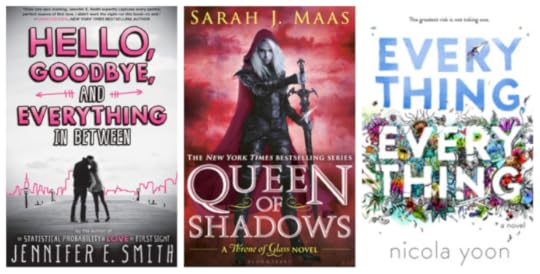
Hello, Goodbye, and Everything In Between by Jennifer E. Smith: High school sweethearts Clare and Aidan spend the night before they leave for college reminiscing about their relationship and deciding whether they should stay together or break up.
Why: Smith’s contemporary teen romances are wildly popular. With recent movie news for one of her backlist titles, I think we’ll be seeing more and more teens looking for her books.
Queen of Shadows by Sarah J. Maas: Everyone Celaena Sardothien loves has been taken from her. Embracing her identity as Aelin Galathynius, Queen of Terrasen, Celaena returns to the empire–for vengeance, to rescue her once-glorious kingdom, and to confront the shadows of her past
Why: This is the fourth installment in the extremely popular “Throne of Glass” series, so you won’t want to miss it. I got a very early finished copy of this book and it’s massive.
Everything Everything by Nicola Yoon: The story of a teenage girl who’s literally allergic to the outside world. When a new family moves in next door, she begins a complicated romance that challenges everything she’s ever known. The narrative unfolds via vignettes, diary entries, texts, charts, lists, illustrations, and more.
Why: Another big-deal book that was a Buzz title at Book Expo America — and for good reason. This is a really enjoyable read, packed with ephemera to help tell the story. It’s also a book that just had its film rights snatched. On a totally unrelated but interesting note — it’s an Alloy property.
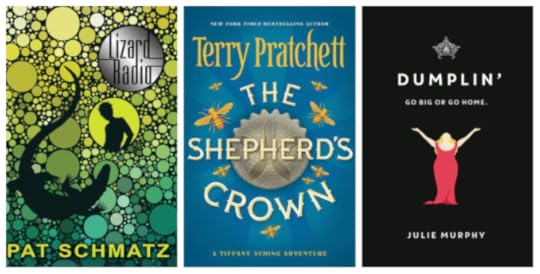
Lizard Radio by Pat Schmatz: Fifteen-year-old bender Kivali has had a rough time in a gender-rigid culture. Abandoned as a baby and raised by Sheila, an ardent nonconformist, Kivali has always been surrounded by uncertainty. Where did she come from? Is it true what Sheila says, that she was deposited on Earth by the mysterious saurians? What are you? people ask, and Kivali isn’t sure. Boy/girl? Human/lizard? Both/neither? Now she’s in CropCamp, with all of its schedules and regs, and the first real friends she’s ever had. Strange occurrences and complicated relationships raise questions Kivali has never before had to consider. But she has a gift–the power to enter a trancelike state to harness the “knowings” inside her. She has Lizard Radio. Will it be enough to save her?
Why: This is a scifi novel with a gender fluid teen and aside from filling a huge hole in YA, it’s a really compelling, engaging, and thought-provoking read.
The Shepherd’s Crown by Terry Pratchett: Tiffany must gather all the witches to prepare for a fairy invasion.
Why: It’s the last Terry Pratchett book and another addition to the “Tiffany Aching” series.
Dumplin’ by Julie Murphy: Sixteen-year-old Willowdean wants to prove to everyone in her small Texas town that she is more than just a fat girl, so, while grappling with her feelings for a co-worker who is clearly attracted to her, Will and some other misfits prepare to compete in the beauty pageant her mother runs.
Why: This book does a fat girl right. Seriously. It’s a fantastic read that’s fun, funny, and heart-filled. In what could be called a trend in this post, the movie rights for this one have been acquired.
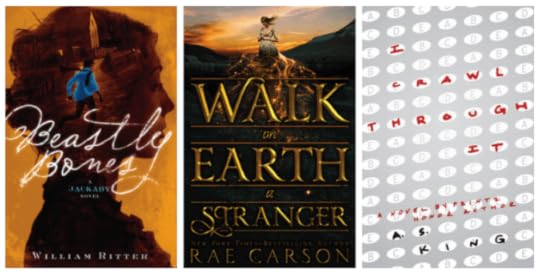
Beastly Bones by William Ritter: When dinosaur bones from a recent dig mysteriously go missing, and an unidentifiable beast starts attacking animals and people, leaving their mangled bodies behind, Abigail and her eccentric employer R. F. Jackaby, investigators of the supernatural in 1892 New England, find themselves hunting for a thief, a monster, and a murderer.
Why: It’s the sequel to Jackaby, which is a perfect book for fans of “Sherlock Holmes.”
Walk on Earth a Stranger by Rae Carson: Lee Westfall has a secret. She can sense the presence of gold in the world around her. Veins deep beneath the earth, pebbles in the river, nuggets dug up from the forest floor. The buzz of gold means warmth and life and home—until everything is ripped away by a man who wants to control her. Left with nothing, Lee disguises herself as a boy and takes to the trail across the country. Gold was discovered in California, and where else could such a magical girl find herself, find safety?
Why: It’s the first book in a new series by Morris Award nominee Rae Carson, and it’s a fantasy western. It looks like a fun twist on both genres.
I Crawl Through It by AS King: A surrealist novel about four teenagers who find unconventional ways to escape standardized tests and their perilous world, and discover that the only escape from reality is to face it.
Why: AS King is a perennial librarian favorite and readers who love strange, surreal worlds will be eager for it.
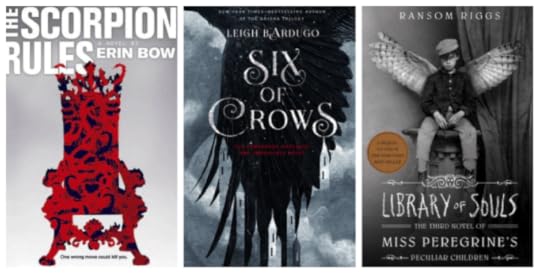
The Scorpion Rules by Erin Bow: A world battered by climate shift and war turns to an ancient method of keeping peace: the exchange of hostages. The Children of Peace – sons and daughters of kings and presidents and generals – are raised together in small, isolated schools called Preceptures. There, they learn history and political theory, and are taught to gracefully accept what may well be their fate: to die if their countries declare war.
Greta Gustafsen Stuart, Duchess of Halifax and Crown Princess of the Pan-Polar Confederation, is the pride of the North American Precepture. Learned and disciplined, Greta is proud of her role in keeping the global peace, even though, with her country controlling two-thirds of the world’s most war-worthy resource — water — she has little chance of reaching adulthood alive.
Enter Elián Palnik, the Precepture’s newest hostage and biggest problem. Greta’s world begins to tilt the moment she sees Elián dragged into the school in chains. The Precepture’s insidious surveillance, its small punishments and rewards, can make no dent in Elián, who is not interested in dignity and tradition, and doesn’t even accept the right of the UN to keep hostages.
What will happen to Elián and Greta as their two nations inch closer to war?
Why: There has been so much buzz about this book, and I’ve received a couple of review copies of it already. I’ve seen a lot of fantastic reviews, including stars from professional journals.
Six of Crows by Leigh Bardugo: Six dangerous outcasts. One impossible heist. Kaz’s crew is the only thing that might stand between the world and destruction–if they don’t kill each other first.
Why: A brand new series by New York Times bestselling and popular author Leigh Bardugo. I believe this is a new series set in the same world of her previous series, too, which should not only bring in new readers, but it’ll be exciting for already-established fans. Again, this has been a buzzy title for a while.
Library of Souls by Ransom Riggs: Time is running out for the Peculiar Children. With a dangerous madman on the loose and their beloved Miss Peregrine still in danger, Jacob Portman and Emma Bloom are forced to stage the most daring of rescue missions. They’ll travel through a war-torn landscape, meet new allies, and face greater dangers than ever. . . . Will Jacob come into his own as the hero his fellow Peculiars know him to be?
Why: Well, the first two books in this series haven’t done too shabby. There’s been a lot of buzz and I suspect we’ll see a huge push for this when it publishes, too.
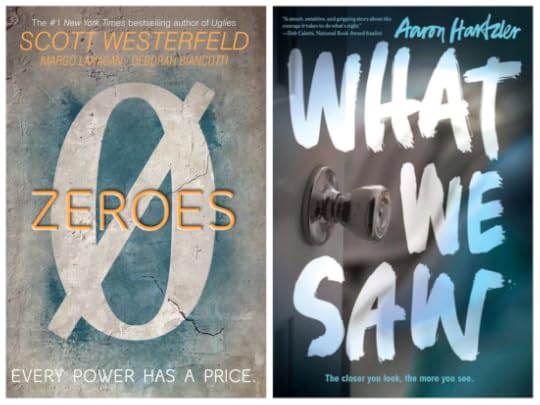
Zeroes by Scott Westerfeld, Margo Lanagan, and Deborah Biancotti: Told from separate viewpoints, teens Scam, Crash, Flicker, Anonymous, Bellwether, and Kelsie, all born in the year 2000 and living in Cambria, California, have superhuman abilities that give them interesting but not heroic lives until they must work as a community to respond to a high stakes crisis.
Why: I’ve actually seen very little said about this new series, but it includes blockbuster name Scott Westerfeld, so it should be on your radar. Margo Lanagan also has some name recognition, at least in the library world.
What We Saw by Aaron Hartzler: The story of a town torn apart by the events surrounding the rape of drunk girl at a house party, from the perspective of the partygoers who witnessed it.
Why: This is another book that addresses rape and rape culture, a topic that needs to continue being talked about. But additionally, this is Aaron Hartzler’s debut into fiction, and it’s impressive.







 Related StoriesGuess The YA Book By Its Subject HeadingsThe Warrior, the Lover, and the Cultist: Three Brief ReviewsHardcover to Paperback Makeovers: 6 YA Changes to Consider
Related StoriesGuess The YA Book By Its Subject HeadingsThe Warrior, the Lover, and the Cultist: Three Brief ReviewsHardcover to Paperback Makeovers: 6 YA Changes to Consider
August 27, 2015
This Week at Book Riot
Over at Book Riot this week…
Looking for book recommendations based on your love (or someone else’s love) of The Perks of Being A Wallflower? I made a big, diverse round-up of next reads and talked a bit about why the book is so beloved.
This week’s “3 on a YA theme” post was about YA takes on Sherlock Holmes. There are some more solid suggestions in the comments for this one, too.
Last weekend, I sent the rest of the big boxes of Some Girls Are / What Goes Around down to South Carolina. I’m going to probably have another small box or two to continue, but Andria started to receive them at the library. Here’s a great photo (and caption!) of the first teens getting the books.
Andria said they were beyond excited that they not only got to read the book, but that they get to keep it:







 Related StoriesThis Week at Book Riot
Related StoriesThis Week at Book Riot
August 26, 2015
Recent Non-Fiction Reads
One of the benefits of slowing down my reading this summer has been wandering through a list I’ve kept of books I thought sounded interesting but that I hadn’t yet picked up. Most of the titles on this list are non-fiction and most of them are adult non-fiction. It’s a category of books I’ve always loved, but I don’t gravitate toward them as much as I once did.
Over the last few months, though, I’ve found myself seeking them out pretty voraciously. It’s not just in the act of slowing down, but it’s also because I’ve been working really hard to readjust some of the flow and focus of my life. I’ve really become invested in trying new things and pushing my thinking and creative limits in new ways. This has manifested in taking some risks and completing projects I’ve thought about but never found the [fill in the blank excuse] to do. This summer, I relearned how to cross stitch and picked up needle felting. I signed myself up for a class on pursuing your dreams for the fall, and I am really ready to dive right in to trying my hand at art journaling. I did a massive house cleaning that required renting a dumpster for hauling away the things I no longer needed, wanted, or had room for in my life.
Choosing to pursue the things that are interesting me at the moment means that I am finally picking up those books on the list. They tend to fall under the category of interesting reads on specific topics. I’d call them microhistories, but it’s not quite the correct term, nor does it encompass the books outside of this particular category I’ve been reading.
Here’s a look at some recent non-fiction I’ve read. Each of these ticked a box for me in some way, and I’m really eager to keep pushing through my list and reading more books that are outside of my comfort/quick pick zone. Having decided to finally try my hand at reading on my phone and using the free trial at Oyster (note: that’s not an affiliate link!), I made a big old list of books that have caught my attention and I’d like to dedicate some time to.
How much do you know about the history of Monopoly? This was a fast-paced read that totally took everything I thought I knew about the classic game and turned it on its head. And, perhaps most interesting and/or infuriating about this, was the history of the game was one of removing the female creator.
In 1904, Lizzie Magie created a game that would become the model for Monopoly. Yet, her side of the story was never told when the Parker Brothers began producing it during the Great Depression. Anyone who has purchased the game — at least, I think it’s still the case in modern editions — knows the “story” behind the game comes in the box. But it’s incomplete, and Pilon’s book offers up the underbelly of greed and scandal.
At times, the legal elements of the book weigh down the narrative, but one of the things that works so well for me when it comes to non-fiction is that these parts are easy to breeze through without feeling like I’m missing out. This book lent itself perfectly to that. The parts that really fascinated me I could linger over and the less-interesting elements I could pass by without feeling like I wasn’t getting something from the read.
An easy, readable book that fans of board games, social history, and the overlooked contributions of women to business should pick up.
The Great Beanie Baby Bubble by Zac Bissonnette
Readers of a certain age probably remember the huge beanie baby phenomenon of the late 90s/early 2000s. This book takes a deep dive into the craze, including what caused it and what eventually made the bubble pop. It’s particularly fascinating for anyone who grew up in the Chicago area; I hadn’t realized that all of this sort of originated in my own backyard. It made a lot of the “craze” that surrounded the trend make more sense to me now, as an adult. I have memories of my mom taking me to O’Hare airport — back in the days before security! — so we could hit up the beanie baby store that was inside.
What made this book so compelling was just how rigid and gross Ty Warner was as a leader of his company. Bissonnette isn’t particularly sympathetic, but the way Ty is rendered — and his ego — is well done and eye-opening. “Limited” and “retired” beanie babies were little more than tools used to raise profits for the company, which anyone who understands basic business understands, but what made this fascinating was how those who collected these, hoping to make a profit, were the ones ultimately put out the most, as their toys didn’t do what they thought they would do. The insight into how Ty worked with McDonald’s for the Happy Meal beanies was a particularly interesting element of the book.
Remember old and new face teddies and how having an “old face” bear meant you had something valuable? The reason the bear’s face changed was 100% because of cuteness. Ty’s focus was on creating the cutest toys possible at a price point that virtually anyone could buy into, though his choice in the stores the toys were available in was very purposeful. You couldn’t get them at large retailers, but rather, at specialty stores only.
This was easily one of the better non-fiction titles I’ve read, and I would recommend it to anyone curious about the behind-the-scenes of a huge phenomenon.
Twelve by Twelve: A One-Room Cabin Off The Grid and Beyond The American Dream by William Powers
I’m fascinated and appalled by the tiny house trend. I hate-watch House Hunters: Tiny Homes pretty passionately. It took me a long time to sort of put my finger on what it was that really annoyed me about the trend and the people who are living this way, and it comes down to this: the same people who are being “eco-conscious” and “budget conscious” in purchasing tiny homes are the same people who would quickly ridicule the people who live in trailer homes because they have no other options. It’s exceptionally privileged, especially as many tiny housers end up getting free land from family to park their custom-built shacks.
Enter Powers and his radical plan to live in a 12×12 tiny house outside of Durham, North Carolina. When I started to read this one, I hesitated a bit, worried that it would be about how enlightened he became to this new way of life and how phenomenally important it was to do things this way in order to be a good human. But this book is not that at all. Instead, Powers talks about the very things this lifestyle affords people who are privileged, and he has enough self-awareness to pick apart the choices he’s made in his own life to see how much of a White Man With Privilege legacy he’s left. The insights are smart and thought provoking, and they don’t shy away from talking about race and racism, including what he witnesses on the property where the tiny home is parked. It isn’t his home, either — it’s one he’s borrowing while a local well known doctor who owns the place is off gridding out west.
What really resonated with me, and the biggest take away from this book, was how Powers talks about what purpose we as people should have on Earth and how it is we should figure out our calling. He does this through noting that the tiny house life and choosing to “do less” isn’t the answer. It can be a means to an answer and it can be a distraction to those who think it’s an answer. Rather, everyone has to have periods where they focus and think through their lives and what it is they can do to improve the world. His own moment of enlightenment wasn’t about how he traveled to other countries and “helped the poor” — in fact, he says he regrets some of the White Savioring that he took part in during those trips — but rather, about how he can enter into the world, respecting the world, and offering himself wholly to it as it is. For him, it’s about doing one nice, selfless thing per day for someone else. It’s simple, but it’s powerful.
I loved Powers’s tone and how he navigates himself through complex social and sociopolitical/economic issues. I’m eager to pick up another book of his because I feel like a lot of how he approaches life offers up much for me to chew on. And that’s what he gets at, too: no one can tell you the answers to your life’s mission and no one can tell you the answers. It’s your responsibility to think about it for yourself, listening to others who have forged their paths and taking/leaving from that what does/doesn’t/won’t/can’t work for you. The answer to his life wasn’t in the tiny house.
All three books are available now and were borrowed from either the library or via Oyster.







 Related StoriesGraphic Novel RoundupRomance Roundup – Eloisa James EditionThe Warrior, the Lover, and the Cultist: Three Brief Reviews
Related StoriesGraphic Novel RoundupRomance Roundup – Eloisa James EditionThe Warrior, the Lover, and the Cultist: Three Brief Reviews
August 25, 2015
Graphic Novel Roundup
FBP: Federal Bureau of Physics vol. 2: Wish You Were Here by Simon Oliver and Robbi Rodriguez
A staff person at the comic book store sold me the first volume of FBP as a good comic for fans of the tv show Fringe, which was a really effective sales technique as well as being true. When I found myself at the comic book store again itching to buy something, volume 2 was a natural pick. Alas, it had been some time since I had read volume 1, and I felt a little lost as I made my way through this one. I vaguely remembered the characters and hoped I’d pick up a greater understanding of the plot as I moved along (sometimes you just have to trust the storytellers). It mostly worked, though I’d still recommend reading this one pretty closely upon a read (or re-read) of volume 1. It involves the two agents of the FBP visiting Nakeet, Alaska for a special experiment where they’re plugged into a machine to allow their minds to create a reality; it’s not meant to bleed into the real reality, but of course, it does in certain ways. A little confusing, but intriguing.
Fables vol. 22: Farewell by Bill Willingham and Mark Buckingham
Late Fables is nothing compared to early Fables, unfortunately. I think the series really ran out of steam near the end, but this final installment is still worth a read. I’m not a fan of the final story arc between Snow White and Rose Red, which was fabricated out of nothing and undid years of deliberate character development. That arc is resolved here in spectacularly anticlimactic fashion. Other threads, too, are wrapped up very quickly. Half the volume is finishing out the main storyline and the other half consists of epilogues telling the final stories of certain characters. I rather enjoyed these (particularly the ones featuring Snow White’s and Bigby’s kids), but I’m a sucker for extended epilogues (I wouldn’t have minded if Return of the King had gone on another half an hour). And while I didn’t care for the last story between Snow White and Rose Red, I was really moved by their epilogue, which takes places thousands of years later. Not a triumphant conclusion, but not a bad one either.
Exquisite Corpse by Penelope Bagieu
Zoe is a “booth babe” with a loser for a boyfriend and no direction in life. One day while on a break at work, she’s sitting outside and notices a man standing out a window in his apartment building. She decides to ask to use his restroom, and he obliges – and they strike up a romance. It turns out he’s quite a famous novelist. Because Zoe never reads novels, she hasn’t even heard of him, which makes it easy for her to remain oblivious to a big secret he’s hiding. He’s quite a bit older than her, eccentric, egotistical. There’s definitely a flavor of a Woody Allen film to the story – until the end, which throws everything for a major loop. I was feeling pretty lukewarm to the story until I got to that point. Then I had to sit there for a long time and really consider whether I like the way it ended or not. And I ultimately decided I did. You’ll have to read to find out, but it doesn’t end like an Allen film, which I think is really the point (I avoid anything he does like the plague now). Bagieu is a French comic and I look forward to seeing what else of hers gets brought to the US.
Rat Queens vol. 2: The Far Reaching Tentacles of N’Rygoth by Kurtis J. Wiebe, Roc Upchurch and Stjepan Sejic
I was in the comic book store wanting to buy Lumberjanes, Nimona, or the second Rat Queens, and all that was available was Rat Queens. One out of three isn’t bad (for my wallet in particular), especially when Rat Queens is as awesome as it is. The second volume collects issues 6-10, and the new illustrator (Stjepan Sejic) begins with issue 9. I really dig Upchurch’s art, but I like Sejic’s just as much (and he’s not an abuser, so extra good human points to him). His lines are a little cleaner, but each character is just as easily recognized, full of sass and personality. I could describe the plot to you, but the characters are really the draw here. We get a little backstory on them, seeing a vulnerable side to each – but no worries, there’s also plenty of bloodshed, foul language, sex, and even some full-frontal male nudity. While a good bit of the story revolves around Dee and a secret person from her past, she still remains the most unknowable to me. Wiebe really seems to love Hannah, and while this is an ensemble story, it’s easy to see how she may be the series’ overarching protagonist. And I mean, she is pretty awesome. Highly recommended.
Strangely for me, all of these graphic novels were published for the adult market. All were personal copies except for Exquisite Corpse, which was provided by the publisher.







 Related StoriesThe Warrior, the Lover, and the Cultist: Three Brief ReviewsRomance Roundup – Eloisa James Edition
Related StoriesThe Warrior, the Lover, and the Cultist: Three Brief ReviewsRomance Roundup – Eloisa James Edition
August 24, 2015
Romance Roundup – Eloisa James Edition
An author whose writing is such that I will listen to her books despite a narrator I dislike is rare. Fortunately for me, Eloisa James is such an author. Most of her books are quite good, almost good enough that I can ignore the annoyances in the narration. Susan Duerden narrates all four of the books below, and while I’m sure many listeners quite enjoy her work (otherwise audiobook producers wouldn’t keep hiring her), she is distinctly not my cup of tea. Every line she reads comes out sing-song, like a teacher trying to get a student to understand the rhythm of iambic pentameter. Oh it is grating. But the books! They are almost all good. I love that many of her heroines have careers, or at least useful passions that occupy a lot of their time (one is a novelist, another is an interior designer) and that she incorporates real historical events into her novels – and not just passing mentions of big wars and the like. In fact, most of them include an author’s note where she expands upon what history is real and what history she tweaked for the purposes of her story. Historical romances with historical author’s notes are my jam.
Three Weeks With Lady X by Eloisa James
Lady Xenobia India is an interior designer, though she’s never referred to by that phrase (I’m assuming because such a thing didn’t really have a name at this point in time). She needed to find a way to to earn money after her parents died, and she has a knack for design and a way of transforming huge, run-down estates into gleaming, modern palaces. Her most recent client is Thorn Dautry, a bastard son of a duke who is in need of sprucing up his image so as to convince the stuck-up mother of the very respectable and sweet Leticia (who is dyslexic but merely thought to be stupid) that he should be allowed to marry her. Thorn has hired India to make over the estate he has purchased, which previously belonged to a man we’d call a party animal in this century. There are lots of leftover X-rated paintings and statuary, for example. The two strike up a flirtation which deepens into true friendship, and then into love. It’s a lovely progression that feels natural, and the bumps in their path to happily ever after are organic. There’s plenty of banter plus a really nice secondary love story between Leticia and another man, which makes the fact that Thorn pursued her and then fell in love with someone else a softer blow. The epilogue to this one even made me tear up a little.
Four Nights With the Duke by Eloisa James
This one features a novelist as the heroine! When she was a child, Mia had a tremendous crush on Evander Brody and wrote a poem about him, which she meant to keep completely secret. Of course it didn’t remain that way, and Vander got a hold of it – or rather his friends did, and they teased him mercilessly about it. To save face, he mocked Mia in return, and of course she was there and overheard. Instant enmity. Flash forward a decade or so and Mia needs a husband for reasons too complicated to get into in this short review. But she doesn’t need just any husband – she needs to marry Vander. Not for long, just for a few weeks, and then she’ll secure an annulment. He’s hardly likely to marry her of his own volition – he’s holding out for a love match – so she blackmails him. Not a great start to a marriage. The premise is a bit contrived, but the emotions are genuine. James does a good job of bringing these two together in love when it seems like it wouldn’t ever be possible. Vander is angry, as he should be, and it provides a believable way for him to act like an asshole without actually being an asshole (unlike some other romance “heroes”). And Mia is awesome. Each chapter begins with her work-in-progress on her newest novel, which is giving her more than a bit of trouble. James drops a couple names of her own writer friends as Mia’s colleagues, and she provides an author’s note that describes in greater detail what the landscape for gothic romances like Mia’s were during that time. This is a love letter to romance novels – those from Mia’s time and those from our own.
Duchess By Night by Eloisa James
Cross-dressing romances are usually pretty fun. Sarah MacLean did one of my favorites, Nine Rules to Break When Romancing a Rake, and I had high hopes for this one (especially after listening to James’ other books above). Harriet is a duchess, a widow whose husband killed himself after a bad game of chess (he loved chess more than he loved her). One of her husband’s responsibilities when he was alive was to help decide court cases, and now it’s fallen her to decide them – like that of a woman who had married five men consecutively and wasn’t quite sure which one was her legal husband. There’s a male judge there who is the “official” decider, but he’s drunk and passed out most of the time, and what she says goes. This is a really interesting bit of history that James elaborates upon in her author’s note, but it doesn’t have a huge amount to do with the romance (aside from character development, I suppose). Harriet is tired of being the staid widow and decides to have a little fun, which is where the cross-dressing comes in. She accompanies one of her female friends to the house of Julian Strange, a notorious partier. Her friend is female and dresses as such, but she decides to go as a man – the better to experience all that the party house has to offer, I suppose. Again, it’s pretty contrived, but it’s good fun. Strange is an OK hero, not terribly memorable but at least he’s not an asshole. When he discovers she’s a woman, it’s pretty funny (most of James’ novels have a good bit of humor in them). I didn’t enjoy this one quite as much as the previous two, but it was still a worthwhile read.
The Duke is Mine by Eloisa James
While the three novels above are all worth a read (and the first two are highly recommended), this one was a total dud. I love the concept of it – it’s a re-working of the Princess and the Pea – but the execution is terrible. I gave up about halfway through, and I never quite figured out exactly how it related to the fairy tale. Perhaps it would have become apparent later, but I wasn’t inclined to stick around long enough to find out. The heroine, Olivia, has been engaged to a man five years younger than her since his birth. Unfortunately, something happened during his birth that damaged his brain, and he never matured beyond the intellect and understanding of a child. Olivia isn’t thrilled to be marrying him, but she’s resigned to it. When her future father in law encourages them to consummate the relationship before her fiance goes off to war (because if she got pregnant the baby would be considered legitimate and he’d have an heir even though his son was dead, which seems specious to me), they both agree. The resulting scene is painful. And not in a funny awkward way. This man is 18 but acts like he’s 8 and he obviously can’t do anything in the bedroom. Just thinking about this scene makes me feel icky. But I persevered (why, I do not know), finally getting to the part where Olivia meets the hero. And he’s supremely boring and is bad at sex. I gave up.
All books borrowed from my local library.







 Related StoriesThe Warrior, the Lover, and the Cultist: Three Brief ReviewsRead a Romance Month
Related StoriesThe Warrior, the Lover, and the Cultist: Three Brief ReviewsRead a Romance Month

